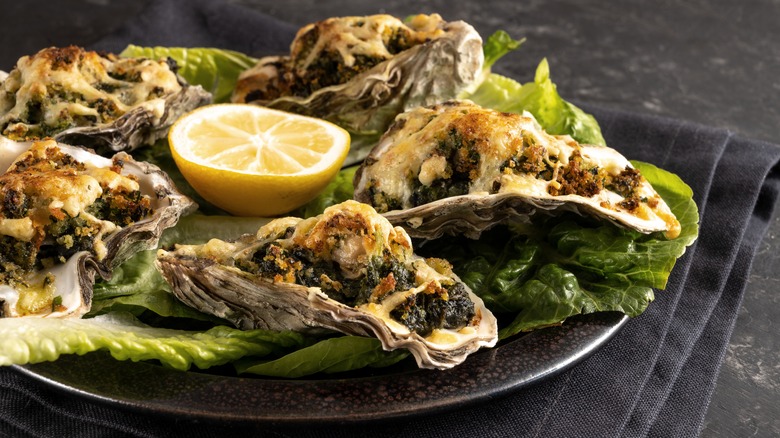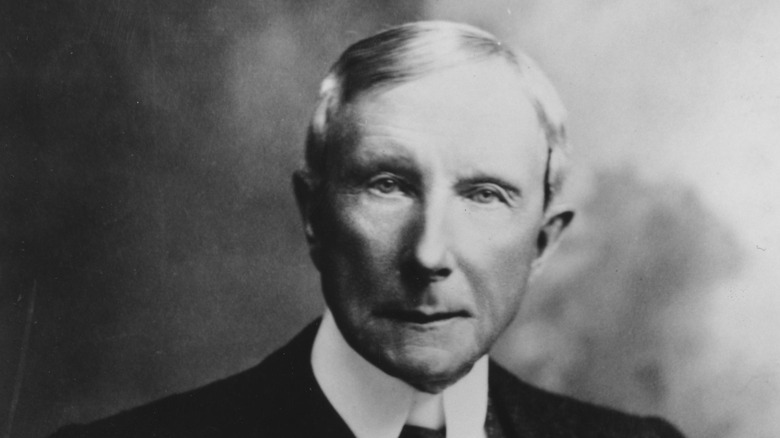How A Shortage Of Snails Caused The Creation Of Oysters Rockefeller
Would you rather eat oysters or snails? For many in the Western Hemisphere, that sounds like a trick question, but the truth is the Americas are behind the curve when it comes to snail-eating. Snails and oysters could be considered comparable delicacies in other parts of the world and different periods of history. Sure, the Ancient Romans loved their oysters (according to New Scientist, the emperor Clodius Albinus could eat 400 oysters in one sitting), but they also cherished snail meat. The BBC reveals that the Romans harvested snails at least 2,000 years ago and considered them precious enough to reserve for society's most elite members.
Today, snail meat is probably best known under its French moniker: escargot. Some Americans might be under the impression that snails are a common meal in La République Français, but Offbeat France explains that most people only eat them on special occasions, particularly to celebrate the New Year. The international perception that snails are a typical French dinner may have originated in Russia after Tsar Alexander visited France in 1814 and was treated to a special celebratory meal of escargot in the Burgundy style. This particular preparation method involves cooking the snails with garlic, butter, and parsley sauce. It's a style that resembles the sauce served on Oysters Rockefeller, and it turns out the similarity is no coincidence.
You can substitute oysters for snails ... apparently
Oysters Rockefeller was invented at the famous New Orleans eatery Antoine's, which is said to be the oldest family-operated restaurant in the United States, dating back to 1840 (via What's Cooking America). Its founder and namesake was the French-born Antoine Alciatore, and one of the signature dishes he brought to New Orleans was Burgundy-style escargot. In 1874, Antoine left Louisiana and returned to France. His health was rapidly deteriorating, and he wished to spend his final days in his homeland. Fortunately, the restaurant survived, ultimately passing into the hands of Antoine's son Jules. He dutifully upheld his father's legacy, but in 1899, he hit a bit of a snag. There was a shortage of French snails at the time, meaning the signature escargot would have to be wiped off the menu — unless he could find a replacement.
In 1899, the idea of cooking oysters was considered somewhat revolutionary, as the mollusks are traditionally served raw. Jules Alciatore broke the mold. According to The Times-Picayune, he chose oysters as a substitute for escargot because they were locally available in New Orleans. He figured using a regional product would help him avoid another shortage. Oysters Rockefeller became the signature dish of Antoine's, and the recipe remains a closely-guarded secret to this day. Recipes are widely available, and many other restaurants serve Oysters Rockefeller, but unless you eat it at Antoine's, you're getting an approximation, not the original.
Why are they called Oysters Rockefeller?
Oysters Rockefeller is named after John D. Rockefeller, the founder of the Standard Oil Company, which Britannica refers to as "... the first great U.S. business trust." Between 1882 and 1911, Standard Oil held a near monopoly on the American oil industry, and Rockefeller became the richest American of all time. Adjusting for inflation, TitleMax estimates that Rockefeller's fortune would be worth $400 billion today. For comparison, the wealthiest person in the world as of January 2023 is Bernard Arnaud, the French CEO of LVMH. This conglomerate includes luxury brands such as Louis Vuitton, Tiffany, and Moët & Chandon. CNBC pegs his net worth at $172-191 billion, nowhere close to Rockefeller's.
So, what does an oil magnate have to do with oysters? Well, when Jules Alciatore invented his famous oyster dish in 1899, Rockefeller was at the height of his power. According to What's Cooking America, the name of the dish is a reference to the tycoon's exorbitant wealth, and it has a double meaning. First of all, Oysters Rockefeller is served with a green sauce, and 'green' is a classic term for American dollars. On top of that, the massive amount of butter that goes into Oysters Rockefeller makes the dish incredibly rich, just like a billionaire. There is even a legend that says one of the first customers to try the dish exclaimed, "Why, this is as rich as Rockefeller!"


